Phison E26 SSD Preview: PCIe 5.0 SSDs Are Finally Here
The fastest drives are just around the corner
Comparison Products
The Phison E26 sample drive is going up against some of the fastest drives on the market, all PCIe 4.0. This includes the Acer Predator GM7000, the Sabrent Rocket 4 Plus-G, the Kingston Fury Renegade, the WD Black SN850X, the Solidigm P44 Pro, the Adata Legend 960, and the Samsung 990 Pro. The Rocket 4 Plus-G has custom firmware using Phison’s I/O+ technology which is also present on the E26. The Black SN850X and 990 PRO also have optimizations to smooth out sustained performance.
Trace Testing - 3DMark Storage Benchmark
Built for gamers, 3DMark’s Storage Benchmark focuses on real-world gaming performance. Each round in this benchmark stresses storage based on gaming activities including loading games, saving progress, installing game files, and recording gameplay video streams.
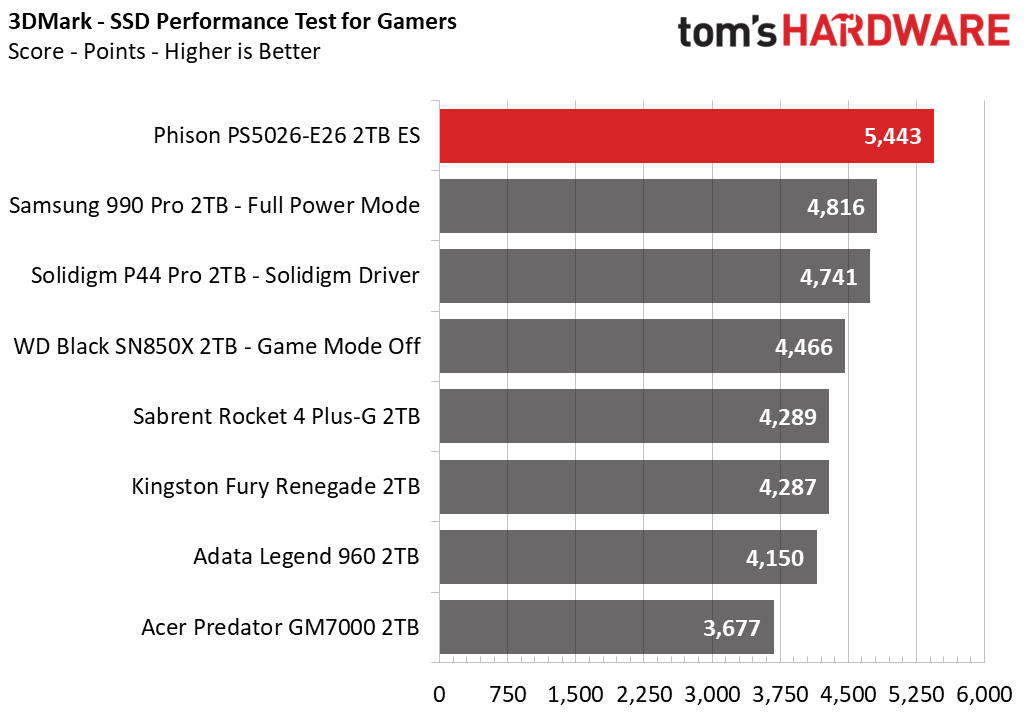
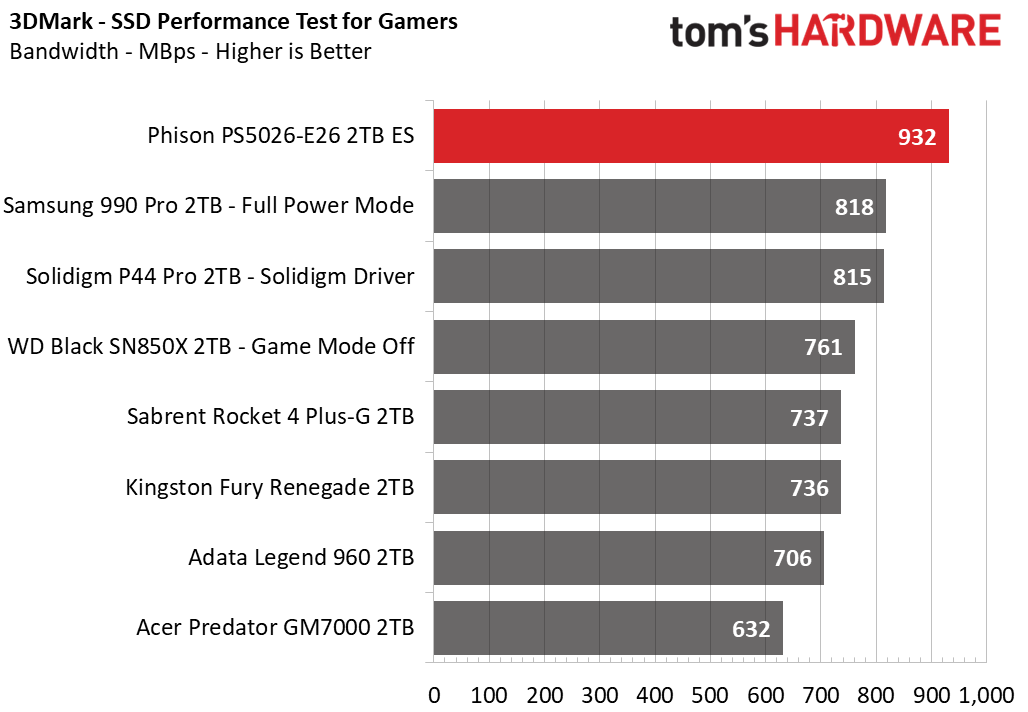

The Phison E26 sample is clearly the fastest SSD in 3DMark, beating the previous champion - the Samsung 990 Pro. The extra bandwidth that PCIe 5.0 offers plus the lower latency of Micron’s 232-layer NAND allow the E26-based SSD to dominate.
Trace Testing – PCMark 10 Storage Benchmark
PCMark 10 is a trace-based benchmark that uses a wide-ranging set of real-world traces from popular applications and everyday tasks to measure the performance of storage devices.
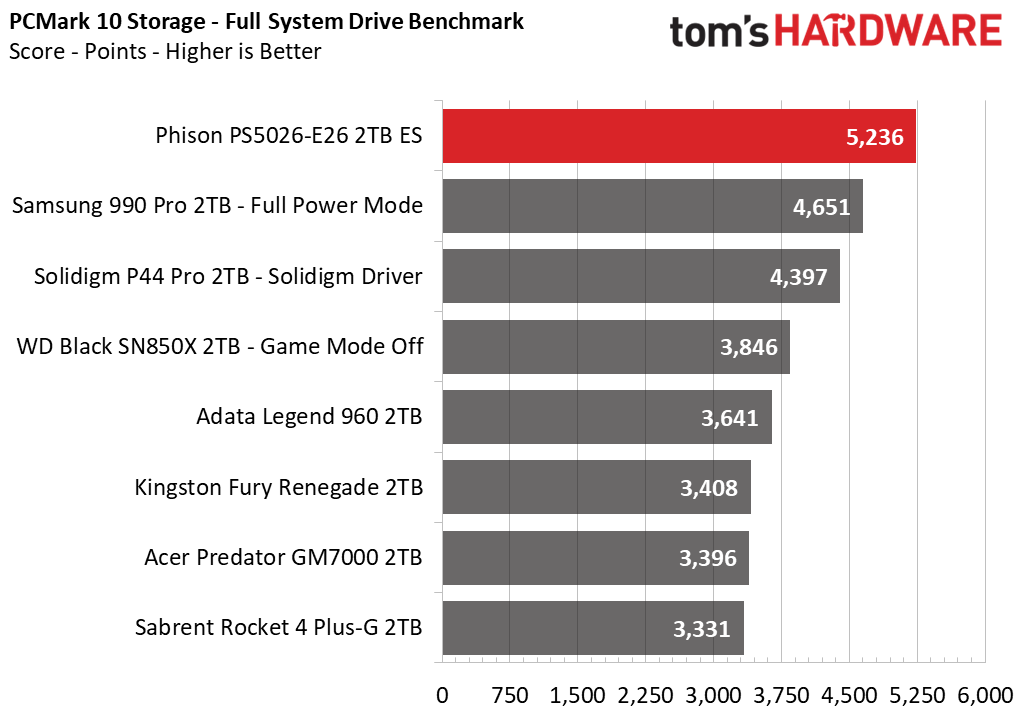
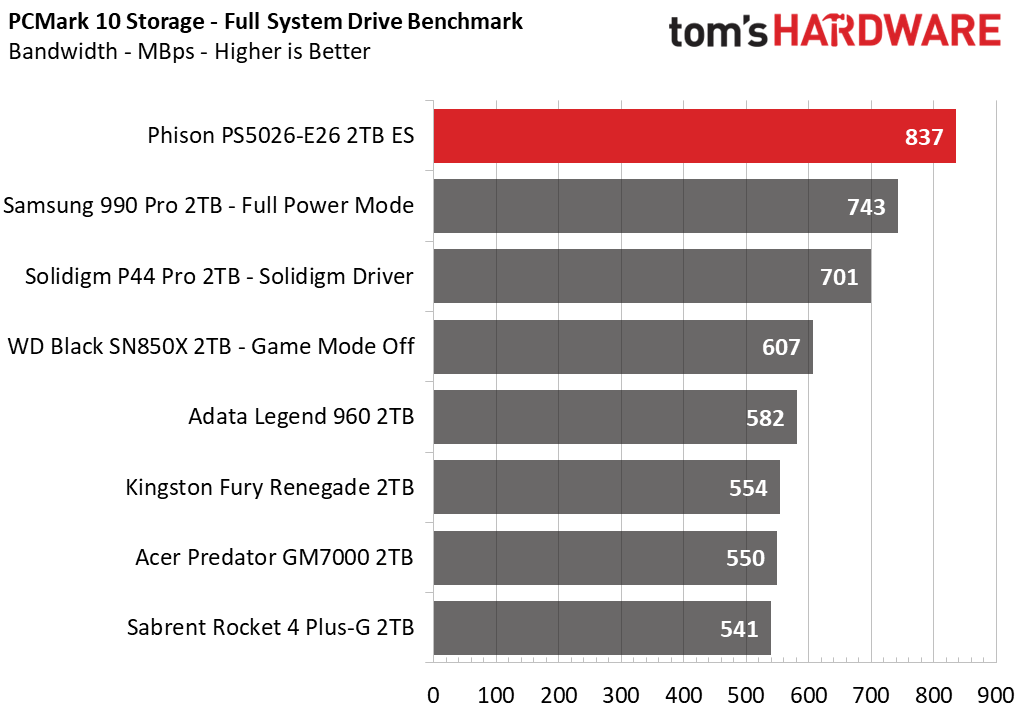

Unsurprisingly, the E26 sample is also the fastest drive in PCMark 10. It would offer an excellent user experience.
Transfer Rates – DiskBench
We use the DiskBench storage benchmarking tool to test file transfer performance with a custom, 50GB dataset. We copy 31,227 files of various types, such as pictures, PDFs, and videos to a new folder and then follow-up with a reading test of a newly-written 6.5GB zip file.
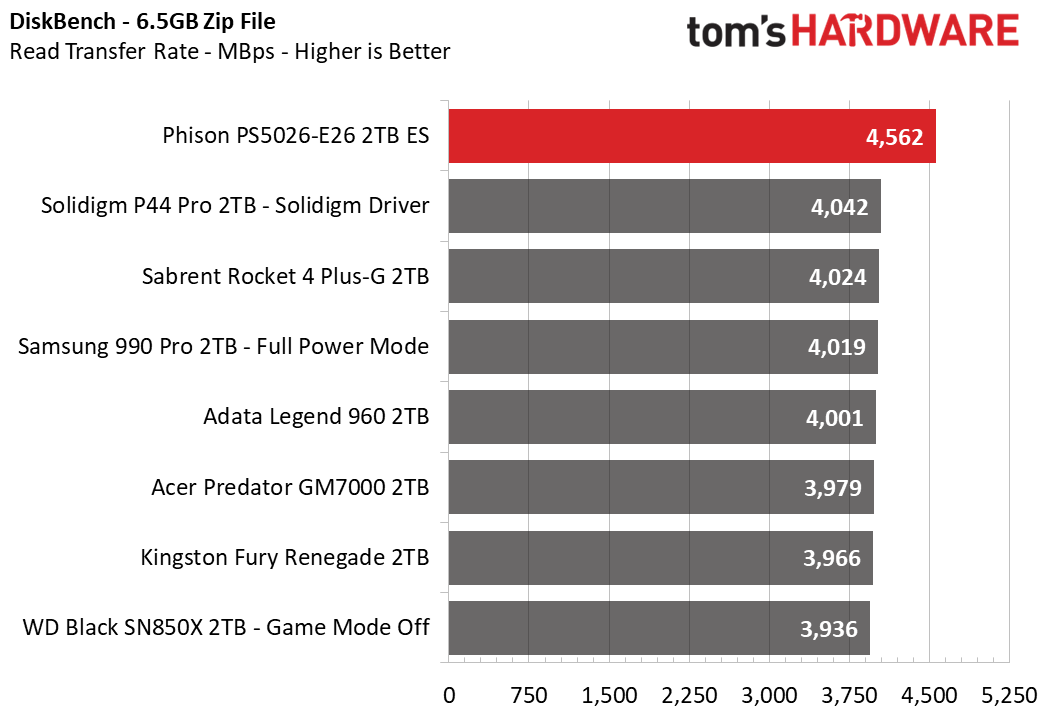

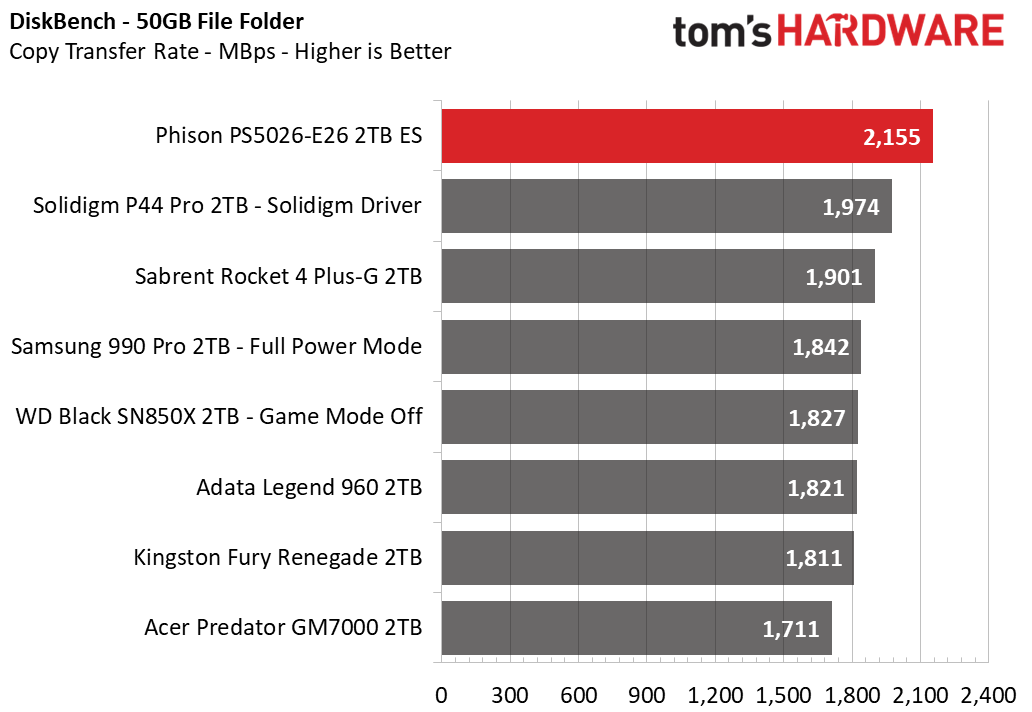
The E26 SSD’s PCIe 5.0 bandwidth helps it transfer data faster than any other drive we’ve yet tested. Performance here perhaps looks underwhelming, but that is due to the mixed nature of the dataset being used which includes smaller files. Combined with the default storage API, the drive’s potential is hampered.
Get Tom's Hardware's best news and in-depth reviews, straight to your inbox.
Synthetic Testing - ATTO / CrystalDiskMark
ATTO and CrystalDiskMark (CDM) are free and easy-to-use storage benchmarking tools that SSD vendors commonly use to assign performance specifications to their products. Both of these tools give us insight into how each device handles different file sizes.
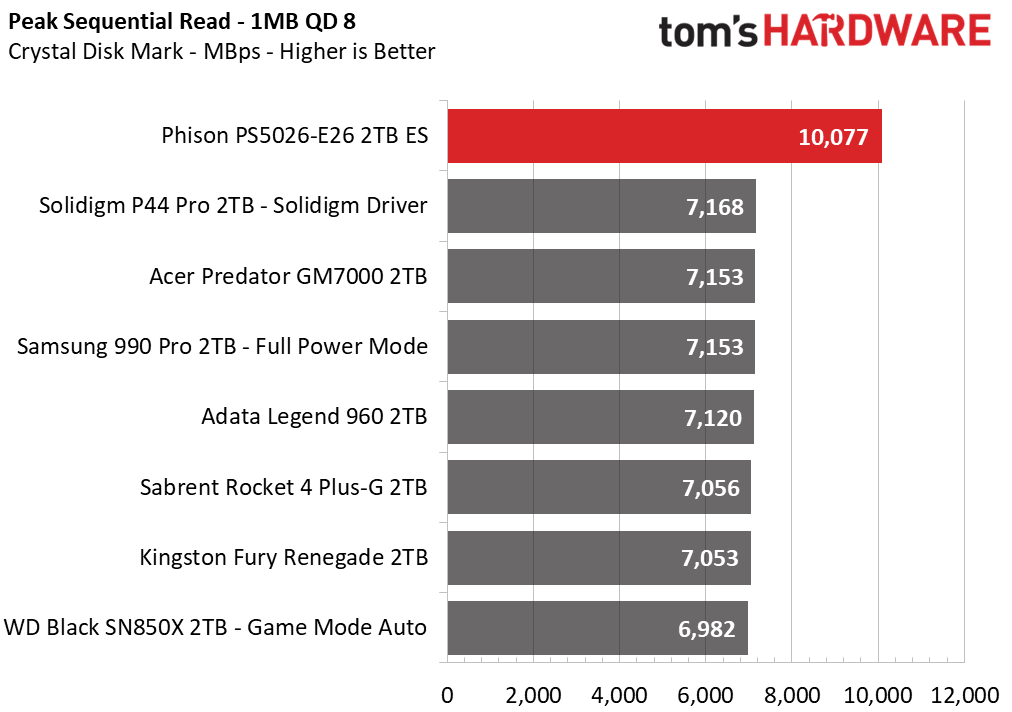
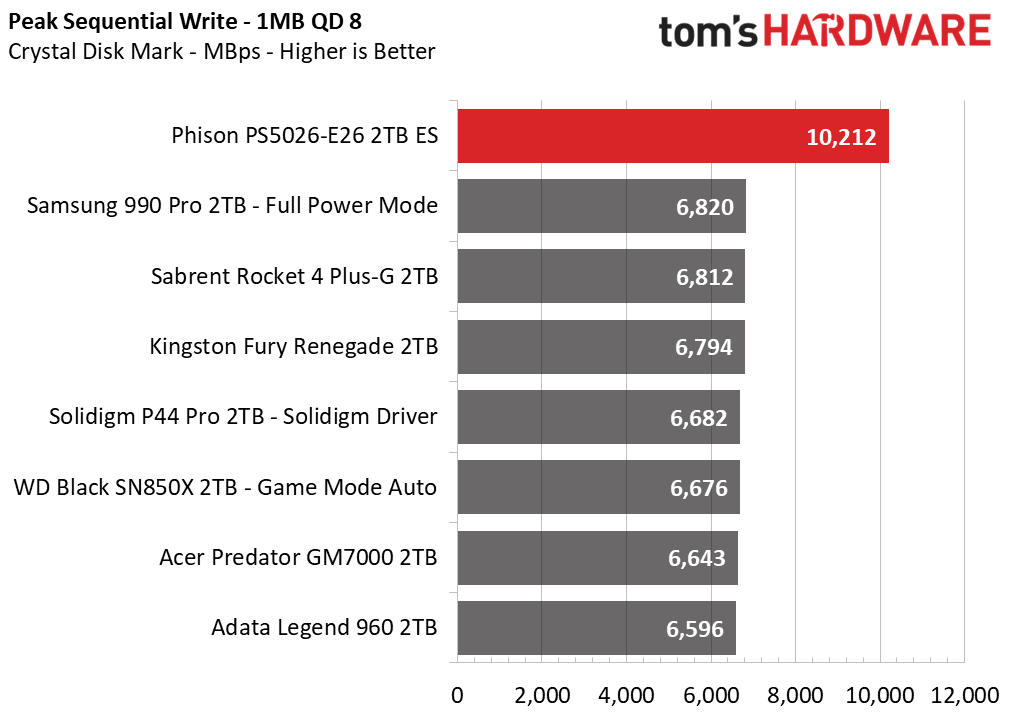


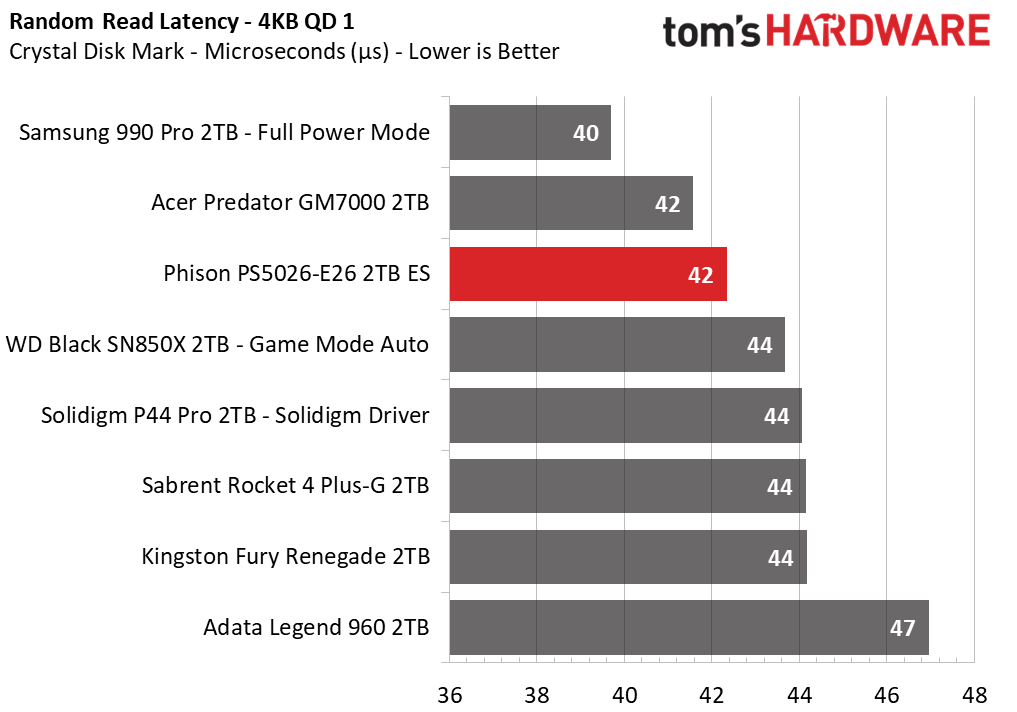
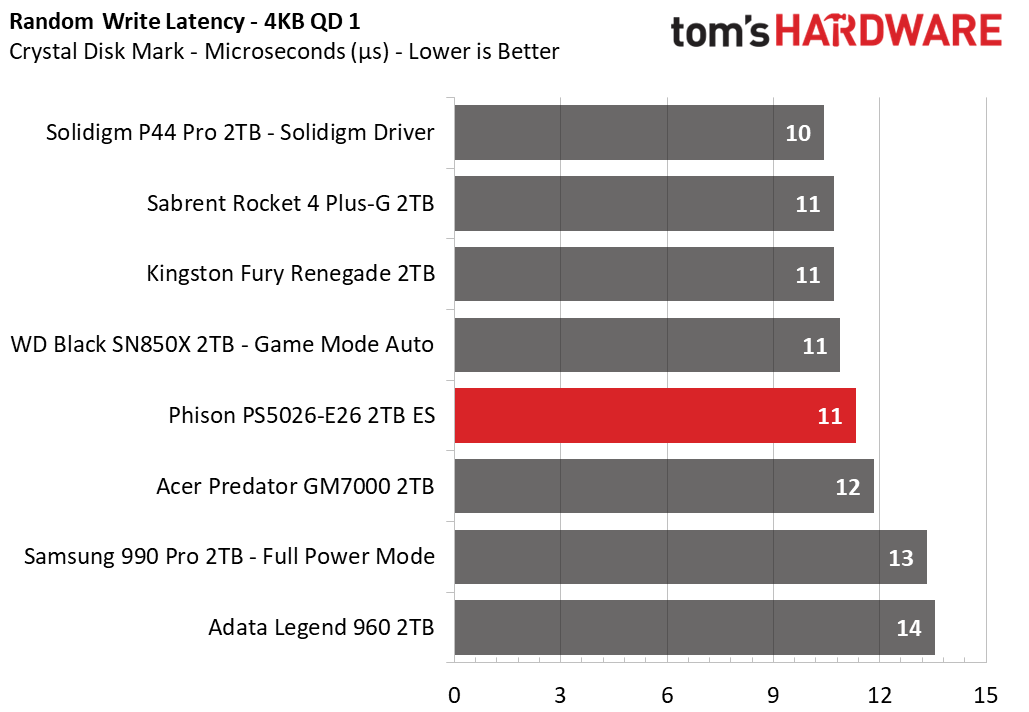

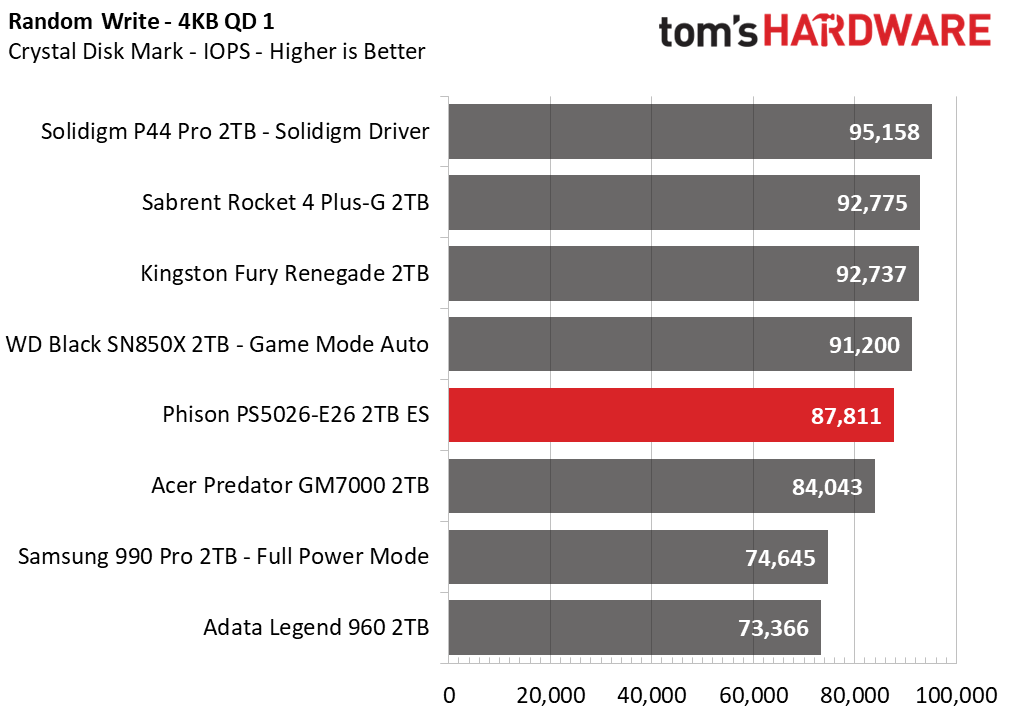
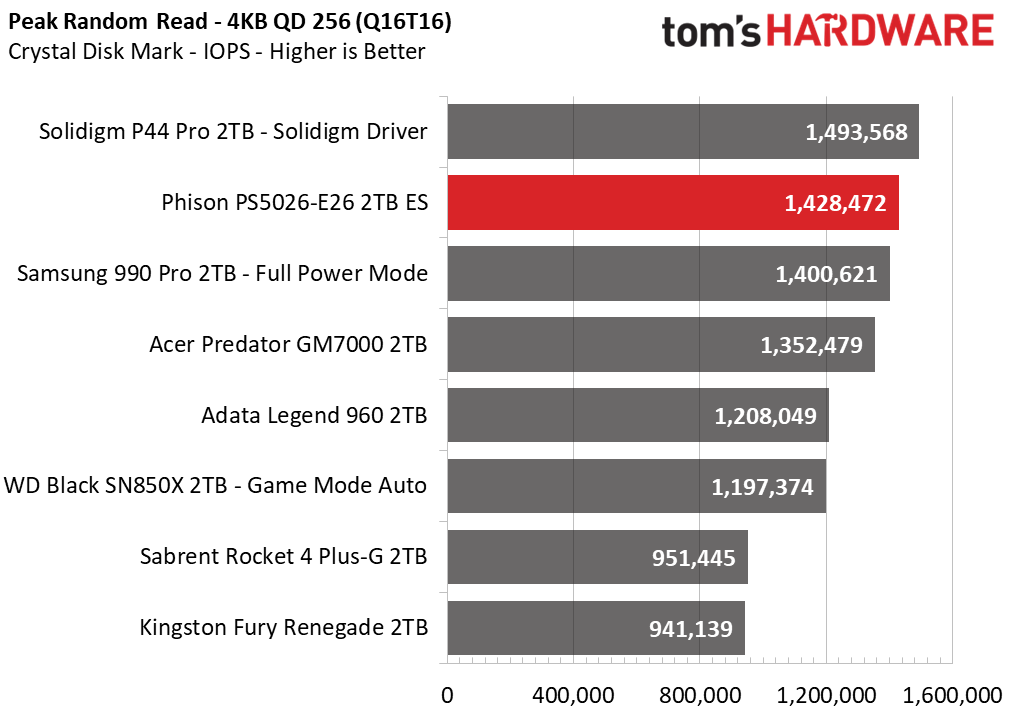
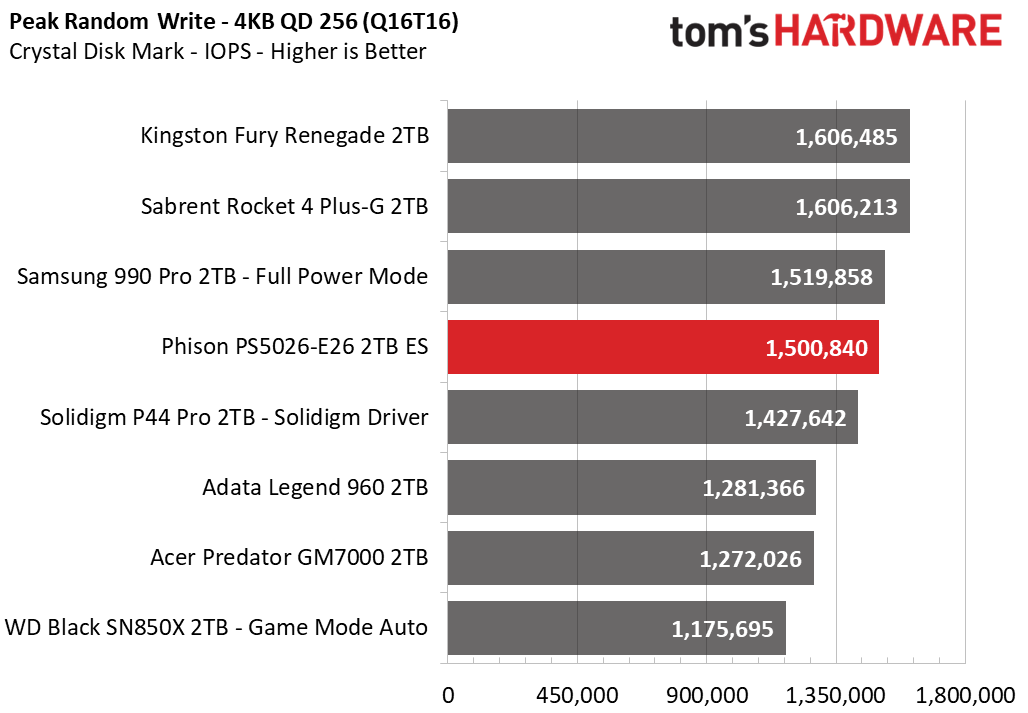

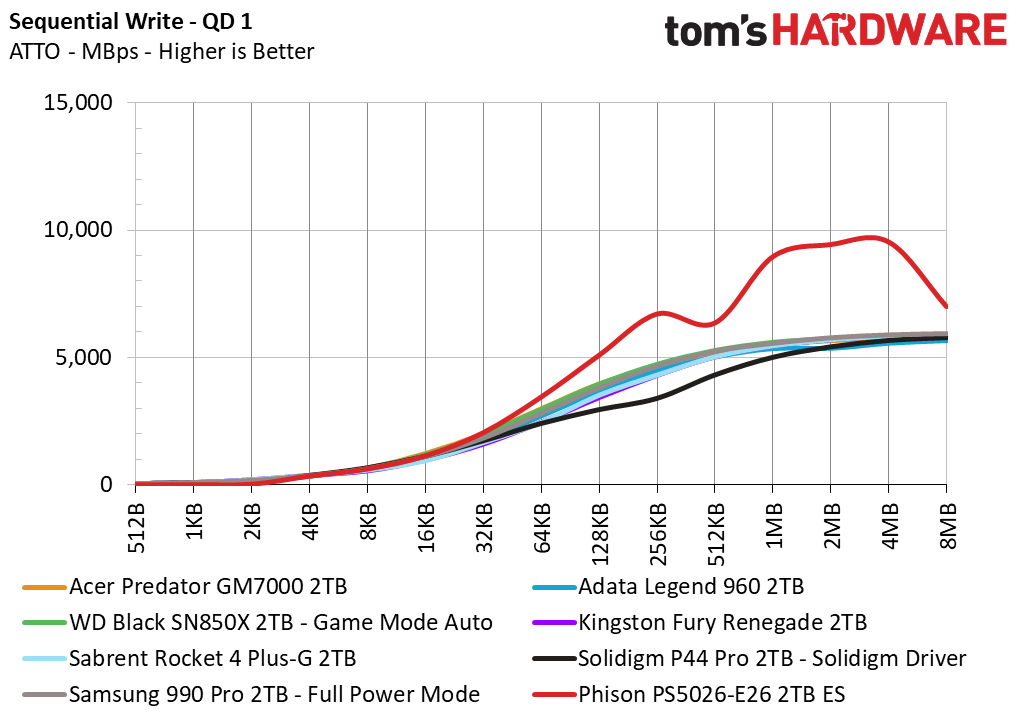
The E26 sample dominates in ATTO sequential thanks to its PCIe 5.0 interface. There is a noticeable dip at 2MB for sequential read which may be a result of the flash architecture given the superpage size on this sample. A minor dip at 512KB for sequential write may be an anomaly or a result of firmware immaturity. Sequential performance in CDM puts the E26 sample firmly in first place, regardless of queue depth or read/write.
Random 4KB performance is fairly good but not exceptional. Further optimization is possible here. The low queue depth results are good enough that you won’t notice the difference, plus the firmware optimization for DirectStorage will probably bring more long-term gains with larger random reads. These results may be due to the E26 controller’s origins or may show that Micron’s new flash is merely iterative of its 176-layer TLC, although there are certainly improvements in other areas.
Sustained Write Performance and Cache Recovery
Official write specifications are only part of the performance picture. Most SSDs implement a write cache, which is a fast area of (usually) pseudo-SLC programmed flash that absorbs incoming data. Sustained write speeds can suffer tremendously once the workload spills outside of the cache and into the "native" TLC or QLC flash.
We use Iometer to hammer the SSD with sequential writes for 15 minutes to measure both the size of the write cache and performance after the cache is saturated. We also monitor cache recovery via multiple idle rounds.
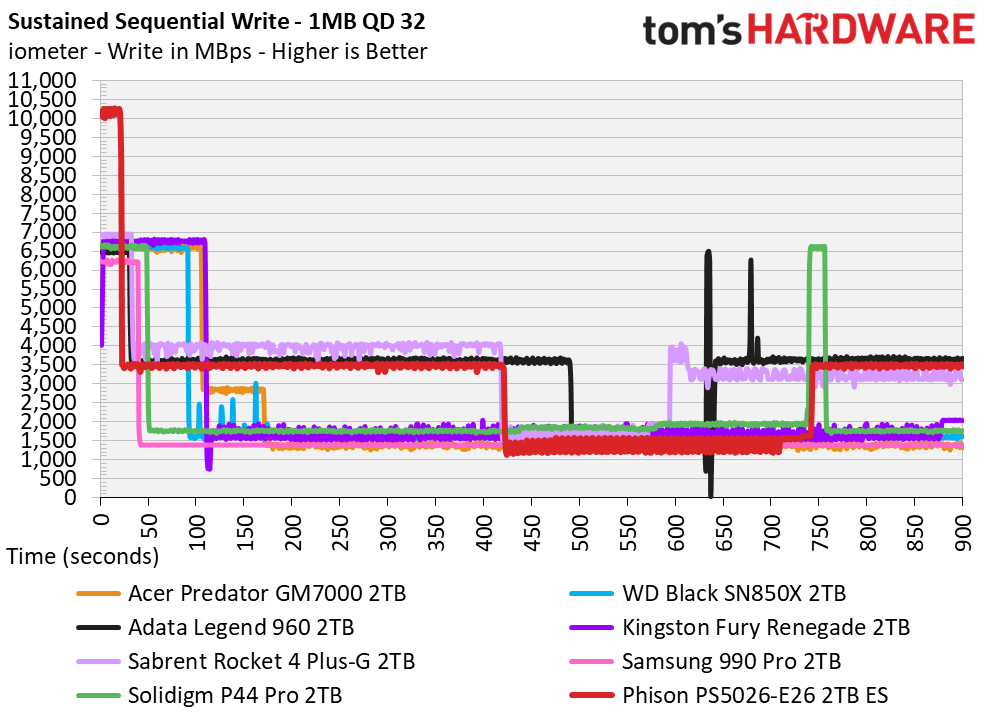
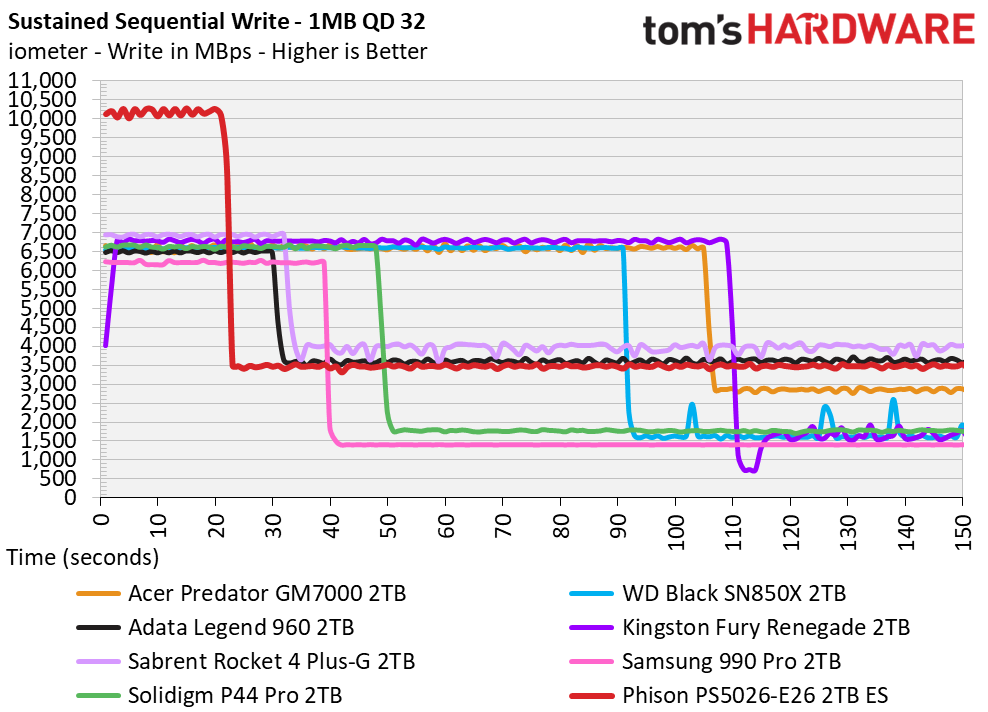

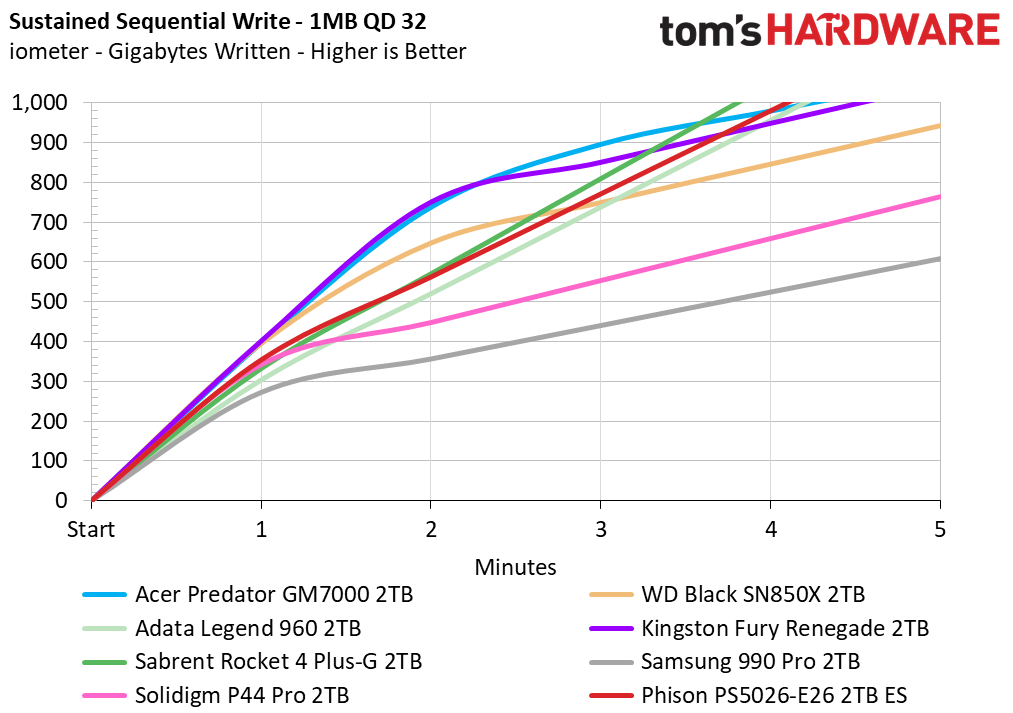
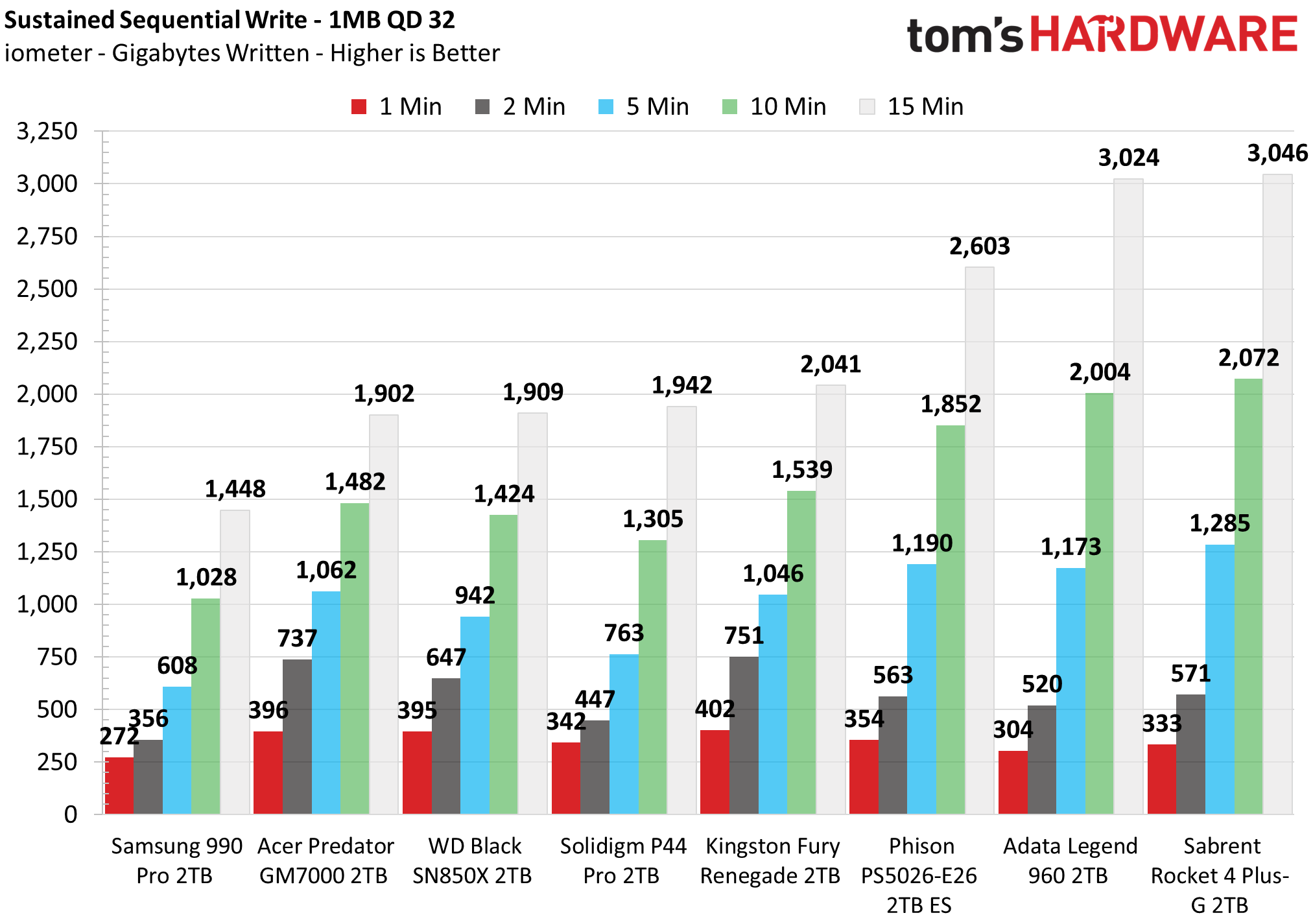
The E26 sample writes at up to 10.2GBps in pSLC mode for over 21 seconds with a cache around 220GB. This is dynamic and conservative in size. The drive then hits a TLC mode at up to 3.5GBps. This mode can be sustained for some time before the folding state hits, where sustained write performance begins to average about 1.36GBps.
This general pattern matches that of the Rocket 4 Plus-G, which is using the Phison E18 controller with Micron’s 176-layer TLC. The E26 controller lets the ES hit much higher speeds in pSLC but it’s about the same speed otherwise, but since it is using denser dies it does not have the same amount of die interleaving with both drives tested at 2TB. The 1TB Rocket 4 Plus-G is slower. This leaves open the possibility of better TLC performance with a 4TB E26 SSD.
Cache recovery is not rapid, as expected. The smaller cache is still large enough to absorb random writes even when the drive is fuller and TLC performance is quite good. Normal use will allow plenty of idle time for the cache to recover while sustained performance will benefit from the smaller cache design.
The E26 ES also has I/O+ technology to improve sustained performance, particularly with random reads for DirectStorage. The first DirectStorage-capable game, Forspoken, is due out this month, and Phison tells me that a software demo will be out later this month.
We use Iometer for sustained write testing and Phison informs me that there is still a performance issue with this benchmarking software. However, it does not affect the results for our type of testing.
Power Consumption and Temperature
We use the Quarch HD Programmable Power Module to gain a deeper understanding of power characteristics. Idle power consumption is an important aspect to consider, especially if you're looking for a laptop upgrade as even the best ultrabooks can have mediocre storage.
Some SSDs can consume watts of power at idle while better-suited ones sip just milliwatts. Average workload power consumption and max consumption are two other aspects of power consumption, but performance-per-watt is more important. A drive might consume more power during any given workload, but accomplishing a task faster allows the drive to drop into an idle state more quickly, ultimately saving energy.
Temperatures are gauged at both idle and load states via sensor and an infrared thermometer. The typical ambient temperature is at 24C. The load state involves sustained writes at maximum speed with measurement ensuing if and until throttling is demonstrated to discover the equilibrium temperature.
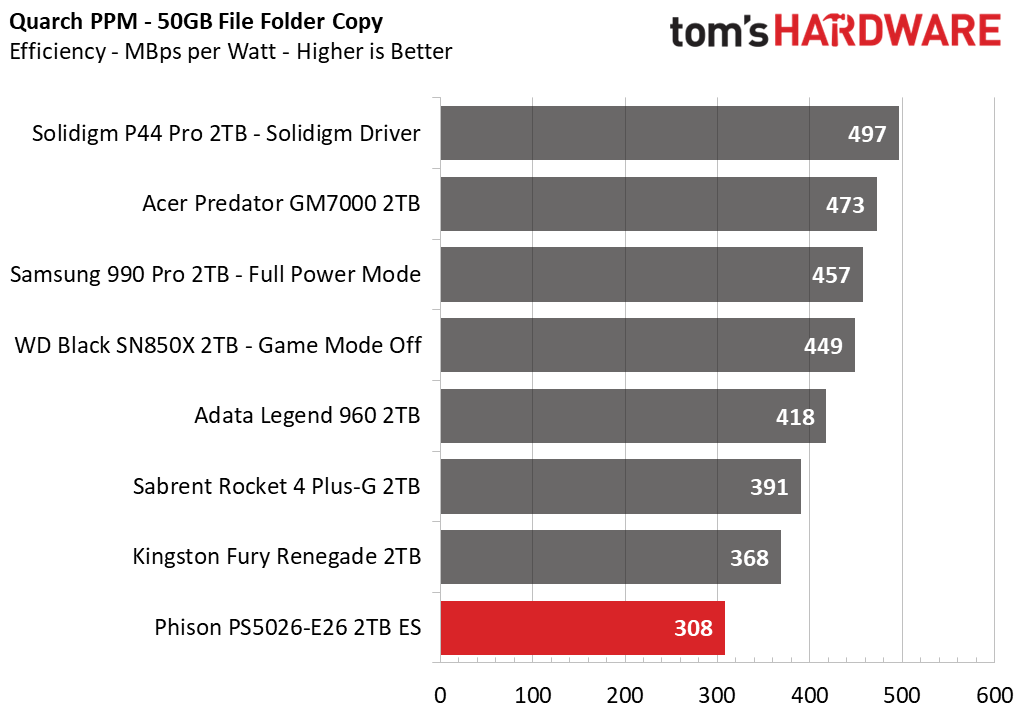
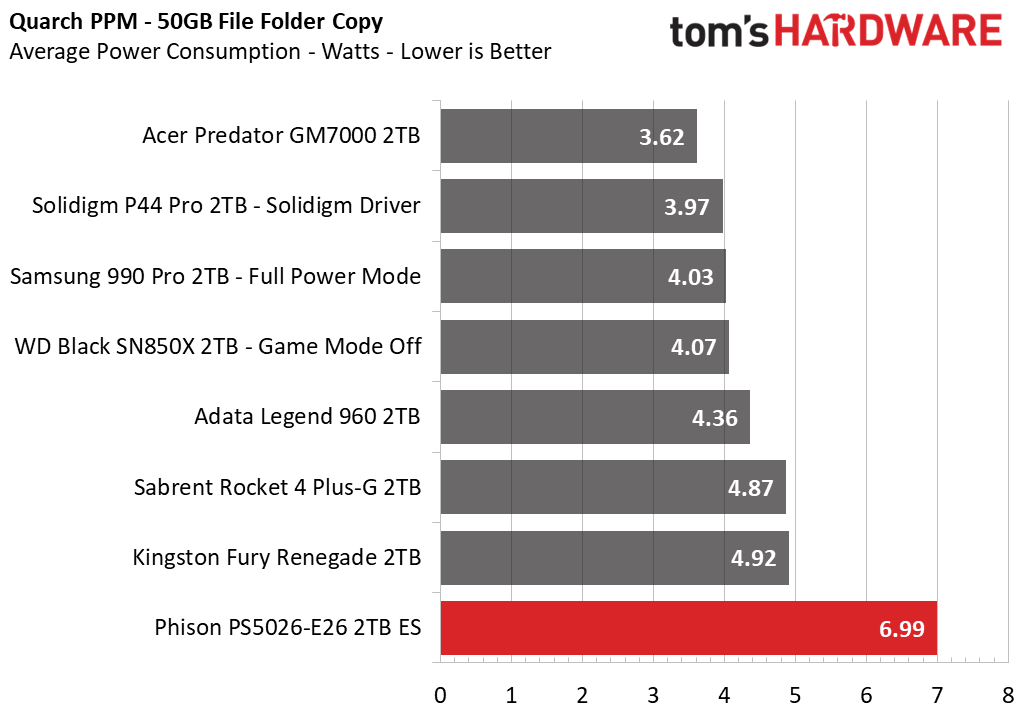
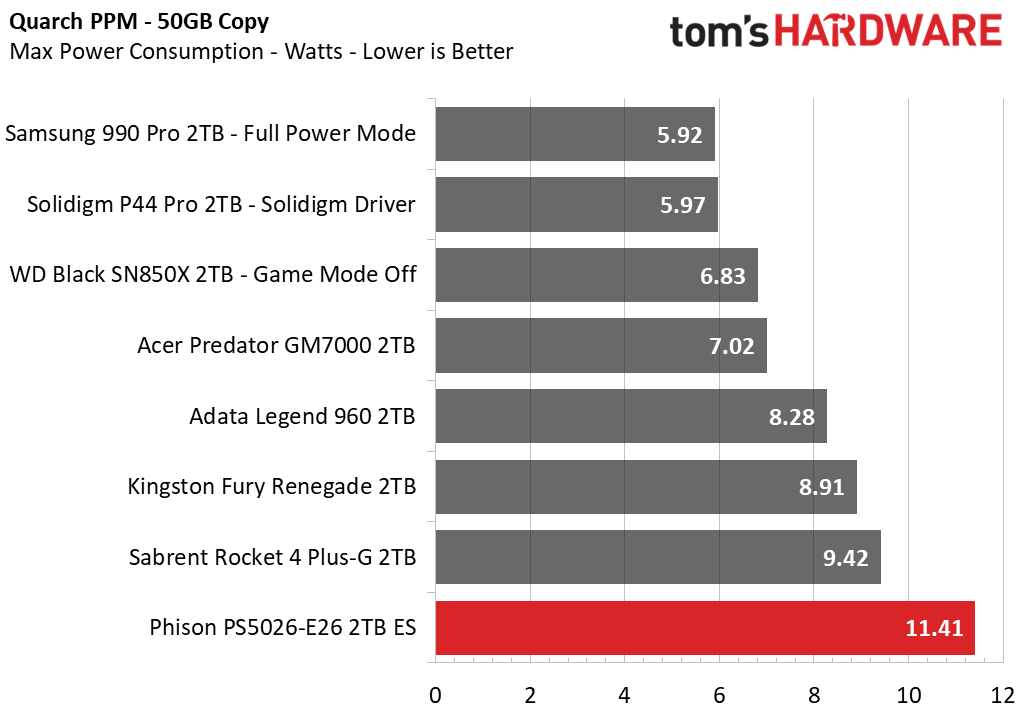
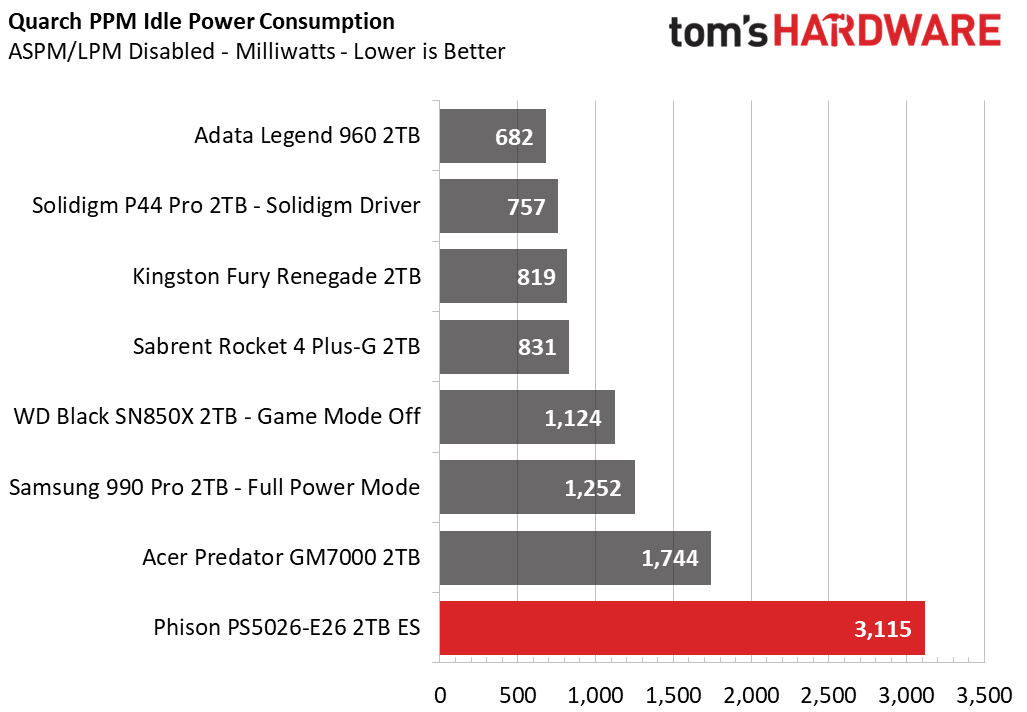
The E26 sample stumbles when it comes to power efficiency. Idle power consumption in particular is quite poor, but it’s unlikely you will be using a drive with active cooling in a laptop and our idle testing is done on a desktop which tends to engage higher power states. Phison informs me that SSDs based on the E26 controller should be more efficient than current high-end PCIe 4.0 drives since they will finish power tests like ours far more quickly, as long as they fall within the same general power and thermal envelopes. This is likely the case as the M.2 form factor has power delivery limitations and improved cooling can prevent the newer drives from throttling.
We reiterate that there can be significant performance swings on PCIe 5.0 SSDs based on the platform, the M.2 or PCIe slot being used, thermal conditions, and other factors. This can influence perceived power efficiency. Newer PCIe 4.0 DRAM-less drives have proven to be very efficient and are usually single-sided so make better sense for wide support and particularly laptop use. Super high-end drives like the E26 sample may require some further maturation and a proper platform in order to get the most out of the hardware. Idle desktop power consumption aside, drives based on the E26 controller should be workload-efficient.
Temperatures were not an issue with the reference cooling design. Drives with the E26 controller and active cooling have previously been spotted so some of this will come down to manufacturer choice. It’s possible that some motherboards, now or in the future, will come with appropriate M.2 heatsinks - assuming your case has proper airflow. We therefore tested this drive naked to see how it handles itself in comparison to other drives.
Without the heatsink the controller idled at around 75C with a composite sensor reading of 55C. Writing 60-80GB of data causes the controller to hit 90C+, causing the drive to throttle and then eventually go offline. This drive absolutely needs a heatsink to hit and maintain PCIe 5.0 speeds.
Test Bench and Testing Notes
| CPU | Intel Core i9-12900K |
| Motherboard | ASUS ROG Maximus Z690 Formula |
| Memory | 2x16GB Corsair Dominator DDR5 5600 CL36 |
| Graphics | Intel Iris Xe UHD Graphics 770 |
| CPU Cooling | Arctic Liquid Freezer II - 420 |
| Case | Streacom BC1 Open Benchtable |
| Power Supply | Corsair SF750 Platinum |
| OS Storage | Sabrent Rocket 4 Plus 2TB |
| Operating System | Windows 11 Pro |
We use an Alder Lake platform with most background applications such as indexing, windows updates, and anti-virus disabled in the OS to reduce run-to-run variability. Each SSD is prefilled to 50% capacity and tested as a secondary device. Unless noted, we use active cooling for all SSDs.
Conclusion
PCIe 5.0 SSDs, like those that will use Phison’s E26 controller, are exciting on paper. Up to 14GBps - which is not the ceiling as faster flash is required to get the most out of this controller - sounds like a lot of bandwidth for non-volatile storage. Some would say too much, as there is already difficulty in detecting any improvement with high-end PCIe 4.0 drives over reliable 3.0 options like the SK hynix Gold P31 or Samsung 970 EVO Plus. Still, there are some improvements, as newer controllers have higher power efficiency with better use of features like host memory buffer (HMB). In fact, budget PCIe 4.0 drives like the WD Black SN770 are quite excellent. The E26 sample SSD, on the other hand, demonstrates that high-end drives of the future will require good cooling.
Phison is at the forefront of SSD development with its I/O+ technology but other manufacturers are also designing their drives to perform smoothly with sustained workloads. DirectStorage will push the limits of drives with deeper queue depth workloads and larger random reads than the 4K most are used to tracking. We can already see hints of unprecedented possibilities with this sample.
The E26 sample set several records in our benchmarks, but does that really matter? Realistically, you will wonder if it’s worth the premium to jump up to a PCIe 5.0 drive. It seems, though, that the premium for 5.0 drives will not match the sticker shock that came with the first high-end 4.0 drives. If you have a platform that can wield this type of SSD it won’t cost you an arm and a leg compared to current high-end drives. You may be willing to pay a little bit more to future-proof your system, although we won’t know until later this year - at the earliest - if that’s a sensible approach, but the option is there.
We are impressed by the performance this sample delivered, knowing that better things are yet to come. We also know that real products are right around the corner and that they should be affordable. The E26 is a pioneering piece of hardware and that should tickle enthusiasts, especially as it is showing off novel six-plane flash with this sample. Many may be less excited because sequential performance is often considered unimportant and DirectStorage maturity is still in the future. The idea of powering and cooling one of these beasts can also be daunting.
There are two other good things about this technology, though. The first is that it brings enterprise features into the mainstream, which will please some power users. It suggests that DirectStorage will actually push SSDs in an effective way and that content creation applications will also benefit from the technology. Furthermore, it shows that newer flash with higher controller bus rates will bring efficient four-channel designs which will rival high-end 4.0 drives while being cheaper. If someone really wants to set records, though, they will have plenty to work with very soon.
MORE: Best SSDs
MORE: Best External SSDs and Hard Drives
MORE: How We Test HDDs And SSDs
MORE: All SSD Content

Shane Downing is a Freelance Reviewer for Tom’s Hardware US, covering consumer storage hardware.
-
DavidLejdar Nice. I have my MB ready for it, AM5, so no taking away of PCIe 5.0 lanes from the GPU. And for casual use it sure seems quite over the top these days - and more so when there is a relatively weak CPU, since such is not likely to make full use of the 4K-random-read IOPS. But as this controller allows for up to 32 TB capacity, that is quite some potential to hope for reasonably priced at least 4TB or even 8TB drives.Reply -
cyrusfox Going to have a hard time to make use of 10GB+/s transfers, 1-2GB/s is plenty, usually don't experience speeds in excess of SATA in actual day to day usage.Reply
Very interested to see how this controller stacks up to best gen4 drives as well as how it compares to the aging and last of the line Optane 5800x. Fully expecting diminishing returns. For mobile though, does 2xlanes PCIe gen 5 take more or less power than 4 lanes PCIe gen 4? That is one application where gen 5 might make sense. -
TechieTwo A year of hype and at least six months late to market with so, so performance. Caveat emptor.Reply -
setx Power consumption is horrible.Reply
What is this drive designed for? For home I'd rather have cool PCIe 4 SSD. For work (saving data from high-speed cameras) sustained write is unacceptable. -
Math Geek what i wonder about most is how do these run so hot? i mean <12w at full throttle is not that much. just trying to figure out how it takes active cooing for very little power used overall. the drive acts like its using 100w.....Reply -
DonQuixoteIII Early days yet, but already the nemesis of quiet is raising its ugly head. If these SSDs require active cooling to avoid throttling, tthen hopefully MB mfg's will re-arrange placement of M.2 slots for easier heatsink placement. Of course, not everyone will need (or want) five of these for their use case (four in a RAID with a spare for redundancy), but there will be some, mostly using workstation level MB's, that do. As well as a few well heeled gamers 'just because'. 28kGBs... Woot!Reply -
bit_user Keeping in mind this is an engineering sample, I think it's pretty impressive.Reply
The first thing that needs to be addressed is why the left side of this graph isn't zero. Since I didn't notice that on any other graph, I'm guessing it was a mistake/oversight:
Next, I found it interesting that it doesn't really pull ahead at sequential reads, until the transaction size reaches 128 kB. Not saying it's a problem, just interesting. Nice that it peaks already by 1 MB, but the subsequent drop seems truly bizarre.
The story with sequential writes is a bit better, although you generally care about that less, since the OS can already buffer short busts at even higher speeds:
Power Consumption is clearly its Achilles heel, using nearly 2x the Samsung 990 Pro's full power mode!
That said, another (lesser) trouble spot is in IOPS and random performance. Hopefully, those areas can be polished a bit, prior to launch.
Anyway, thanks for the preview! It's interesting to see how much difference it made in the application benchmarks. Nice to see it noticeably pull ahead in something more than pure synthetics!